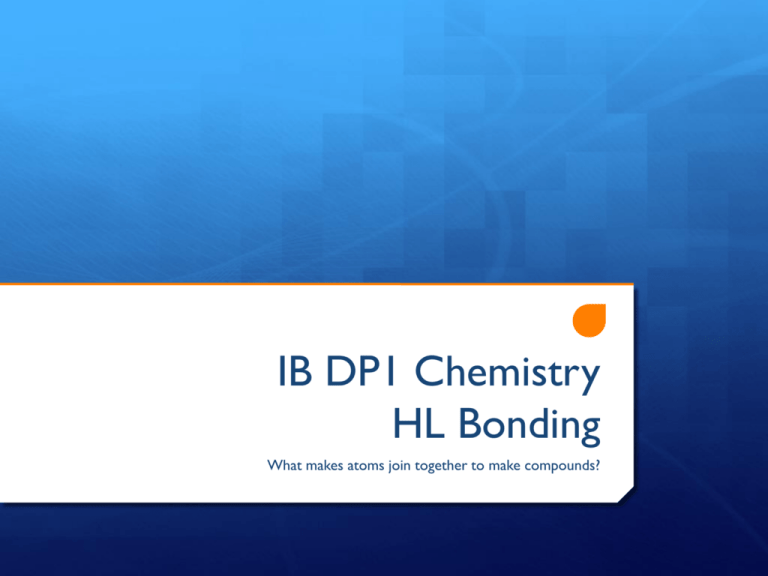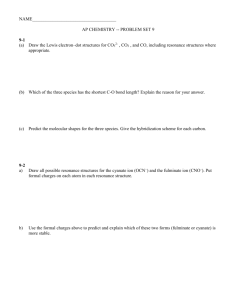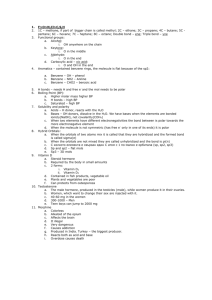Bond
advertisement

IB DP1 Chemistry HL Bonding What makes atoms join together to make compounds? Topic 14: Bonding 14.1 Shapes of molecules and ions 1 hour 14.1.1 Predict the shape and bond angles for species with five and six negative charge centres using the VSEPR theory. 14.2 Hybridization 2 hours 14.2.1 Describe σ and π bonds. 14.2.1 Describe σ and π bonds. 14.2.2 Explain hybridization in terms of the mixing of atomic orbitals to form new orbitals for bonding. 14.2.3 Identify and explain the relationships between Lewis structures, molecular shapes and types of hybridization (sp, sp2 and sp3). 14.3 Delocalization of electrons 2 hours 14.3.1 Describe the delocalization of π electrons and explain how this can account for the structures of some species. Schrodinger wave equation Which energy level is an electron in? 1st quantum number 2nd quantum number 1 p 3rd quantum number Electron orbital shapes (2nd quantum number) http://chemwiki.ucdavis.edu/Physi cal_Chemistry/Quantum_Mechan ics/Atomic_Theory/Electrons_in_ Atoms/Electronic_Orbitals Electron energy levels Hybridization atoms circular electron shells 2,8,8,…orbitals s,p,d,f,… s, p, d, f orbitals only for single atoms in gaseous state hybridization electron orbitals change shape (and energy) during bonding σ-bond strongest form of covalent bond orbitals overlap on line between nuclei commonly s+s, pz+pz, s+pz Image: http://en.wikipedia.org/wiki/Pi_bond π-bond orbital overlap not on line between nuclei usually weaker than sigma bonds stop rotation Image: http://en.wikipedia.org/wiki/Pi_bond Orbital shapes of spdf orbitals and hybrid ized orbitals Image: http://en.wikipedia.org/wiki/Pi_bond Electronic configuration of carbon 2 2 2 1s 2s 2p Methane sp3 hybridization 2s and 2p3 orbitals hybridize Ethane, ethene and ethyne Carbon-carbon bonds Bond type ethane single Bond energy (kJ/mol) 348 Bond length (pm) 154 ethene double 612 134 ethyne triple 837 120 • Describe and explain the change in bond energy • Describe and explain the change in bond length Hybrid orbitals Single bond (ethane) one axial C-C s -Bond Hybridisation: one s-orbital and three p-orbitals four sp3-orbitals The sp3-orbitals have a tetrahedral shape (109.5o). Double bond (ethene) one axial s -bond and one offset p-bond Hybridisation: one s-orbital and two p-orbitals three sp2-orbitals The sp2-orbitals have a trigonal planar shape, 120o Triple bond One axial s -bond and two offset p -bonds Hybridisation: One s-orbital and one p-orbital Two sp-orbitals The sp-orbitals give a linear shape The shape of the hybrids corresponds to the structure given by VSEPR / Lewis structure. Ethane : Ethene : Ethyne sp3 : Ammonia: sp3 Water: sp3 sp2 : sp Electrons not associated with a particular atom or bond are delocalized metallic bond Benzene, C6H6 ring B A The p-bond in the double bond can switch place Electrons are delocalized. A and B: resonance structures. C: resonance hybrid. Molecule gains resonance energy by delocalizing electrons. C Image: http://commons.wikimedia.org/wiki/File:Benzene_resonance_structures.png Resonance bond Resonance describes delocalized electrons within some molecules or polyatomic ions where the bonding cannot be expressed by one single Lewis formula. A molecule or ion with such delocalized electrons is represented by several resonance structures. Draw the structures of NO3-, CO32-, O3







